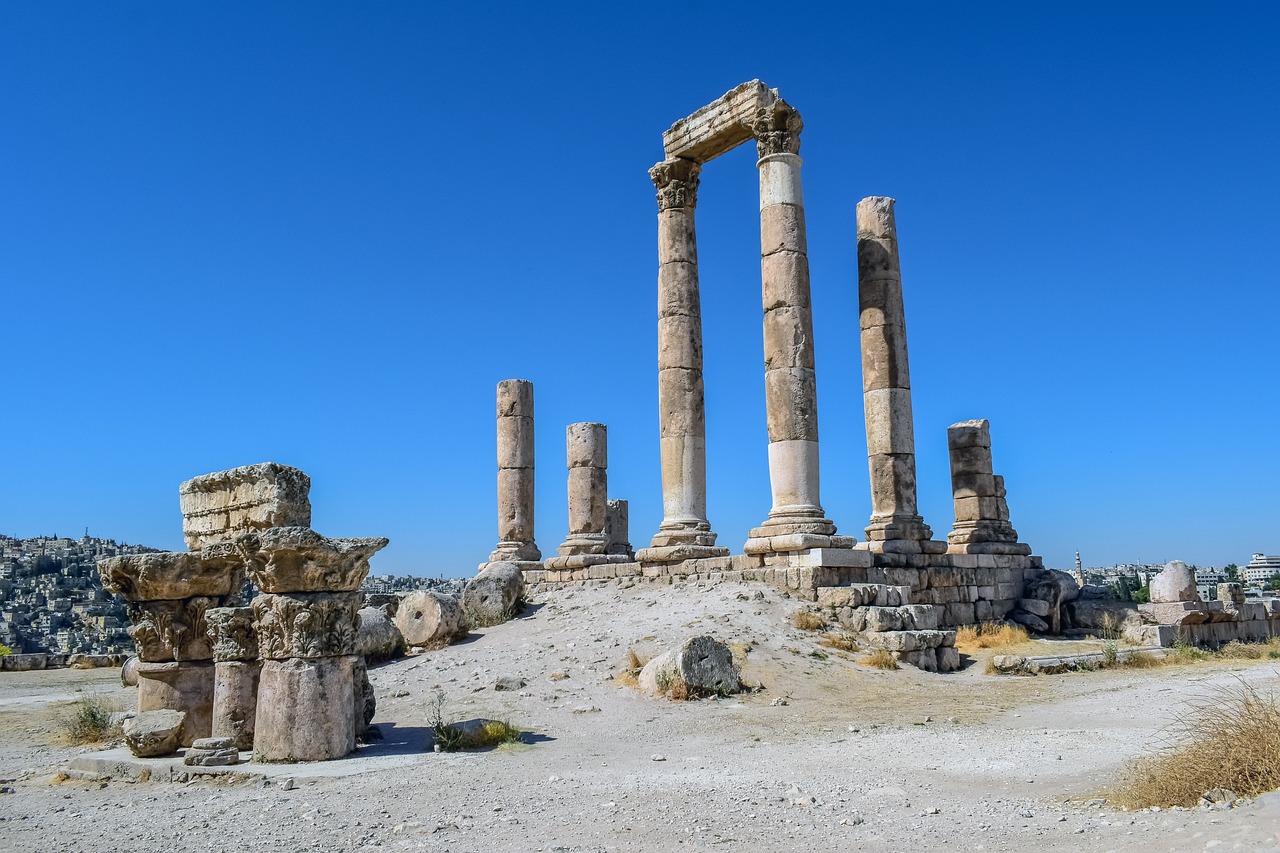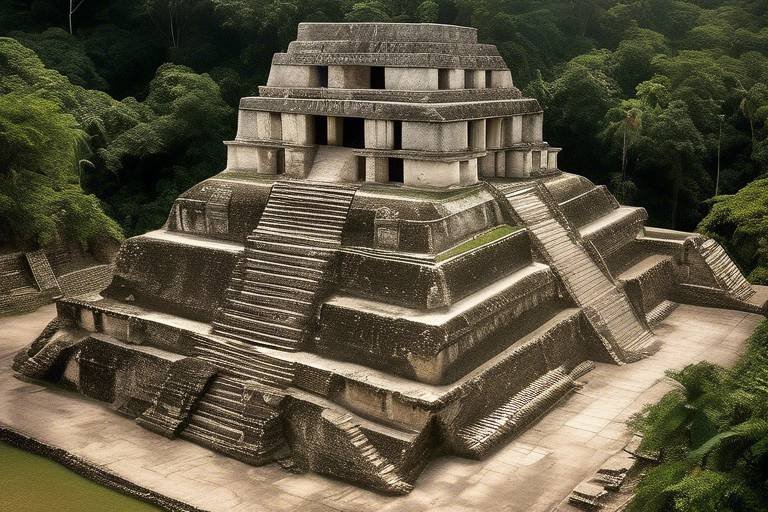The Influence of Ancient Persia on Philosophy and Science
Ancient Persia, with its rich history and vibrant culture, has left an indelible mark on the realms of philosophy and science. The legacy of this ancient civilization reverberates through the corridors of time, influencing modern thought and scientific advancements in profound ways. By delving into the depths of Ancient Persia, we can uncover a treasure trove of knowledge that continues to shape our understanding of the world.

Zoroastrianism's Influence on Philosophy
Zoroastrianism, the ancient Persian religion founded by the prophet Zoroaster, has had a profound influence on philosophical thought throughout history. One of the key contributions of Zoroastrianism to philosophy is the concept of dualism, which posits the existence of two opposing forces, representing good and evil. This dualistic worldview has shaped philosophical discussions on the nature of morality, ethics, and the eternal struggle between light and darkness.
Furthermore, Zoroastrianism's emphasis on ethical principles and the importance of leading a virtuous life has resonated with various philosophical schools over the centuries. The idea of individual responsibility for one's actions and the belief in a final judgment based on moral conduct have been central themes in philosophical debates influenced by Zoroastrian thought.
Moreover, the concept of Ahura Mazda as the supreme deity in Zoroastrianism, representing wisdom, truth, and goodness, has inspired philosophical inquiries into the nature of divinity, the existence of a higher power, and the relationship between the material and spiritual realms. The rich symbolism and intricate cosmology present in Zoroastrian texts have sparked philosophical contemplation on the origins of the universe and humanity's place within it.
Overall, Zoroastrianism's profound influence on philosophy can be seen in the enduring discussions on dualism, ethics, metaphysics, and the eternal struggle between good and evil that continue to shape philosophical thought to this day.

Ancient Persian Scholars and Mathematics
Ancient Persia boasts a rich history of scholarly achievements, particularly in the field of mathematics. Persian scholars like Al-Khwarizmi made significant contributions that laid the foundation for algebra and trigonometry, shaping the course of mathematical development for centuries to come. Al-Khwarizmi's work in the Islamic Golden Age not only advanced mathematical understanding but also influenced the way mathematics was taught and applied.
One of the most notable contributions of Persian scholars to mathematics was the introduction of the decimal system and the concept of zero, revolutionizing numerical notation and calculation methods. This innovation had a profound impact on the field of mathematics, paving the way for complex mathematical operations and the development of intricate mathematical theories.
Moreover, Persian mathematicians excelled in the study of geometry, laying down fundamental principles that are still used in modern mathematics. Their geometric discoveries not only expanded the understanding of spatial relationships but also played a crucial role in the advancement of architecture, engineering, and other scientific disciplines.
Through their meticulous observations and rigorous mathematical analyses, ancient Persian scholars enhanced the understanding of mathematical concepts such as algebraic equations, geometric theorems, and trigonometric functions. Their work not only contributed to the intellectual growth of their time but also left a lasting legacy that continues to shape mathematical thought and practice today.

Medicine and Healing Practices in Ancient Persia
Ancient Persia was renowned for its significant contributions to the field of medicine and healing practices, paving the way for advancements that influenced the development of medical knowledge worldwide. Persian physicians, such as Avicenna, made groundbreaking discoveries that shaped the course of medical history.
One of the most notable contributions of ancient Persian medicine was the Canon of Medicine, a comprehensive medical encyclopedia written by Avicenna. This monumental work became a standard medical text in Europe for centuries, encompassing a wide range of medical topics and emphasizing the importance of observation and experimentation in diagnosis and treatment.
Furthermore, Persian physicians in ancient times were pioneers in the fields of pharmacology and surgery. They developed sophisticated methods for preparing and administering herbal remedies, as well as conducting surgical procedures with remarkable precision and skill.
Not only did ancient Persia excel in medical theory and practice, but it also prioritized preventive medicine and holistic approaches to healthcare. Persian healers emphasized the interconnectedness of the body, mind, and spirit, advocating for a balanced lifestyle and dietary habits to maintain overall well-being.
The influence of ancient Persian medicine extended far beyond its borders, influencing medical practices in neighboring regions and laying the foundation for future medical advancements. The legacy of Persian healing traditions continues to resonate in modern healthcare practices, underscoring the enduring impact of ancient Persia on the field of medicine.

Persian Astronomy and Observational Techniques
Exploring the fascinating realm of Persian astronomy unveils a rich tapestry of knowledge and innovative observational techniques that have left an indelible mark on the history of science. Persian scholars, notably Nasir al-Din al-Tusi, made significant advancements in the field, revolutionizing astronomical understanding and observational practices.
One of the key contributions of Persian astronomy lies in the development of sophisticated observational instruments, such as the astrolabe, which enabled precise measurements of celestial objects and movements. These tools not only enhanced the accuracy of astronomical calculations but also paved the way for future discoveries in the field.
Moreover, Persian astronomers excelled in the study of celestial phenomena, meticulously documenting planetary motions, eclipses, and the positions of stars. Their meticulous observations laid the foundation for a more comprehensive understanding of the cosmos and influenced the evolution of astronomical theories.
The astronomical achievements of Persian scholars extended beyond mere observation, encompassing theoretical advancements as well. Nasir al-Din al-Tusi, a prominent figure in Persian astronomy, proposed innovative models of planetary motion, challenging existing paradigms and contributing to the development of scientific thought.
Furthermore, Persian astronomers played a crucial role in preserving and translating ancient Greek astronomical texts, ensuring the transmission of knowledge across cultures and generations. This cross-cultural exchange enriched the field of astronomy and fostered a spirit of collaboration and intellectual growth.
In essence, the legacy of Persian astronomy endures as a testament to the ingenuity and curiosity of ancient scholars who gazed at the stars and sought to unravel the mysteries of the universe through meticulous observation and innovative techniques.

Philosophical Schools in Ancient Persia
Ancient Persia was not only a cradle of civilization but also a hub of philosophical exploration. The philosophical landscape of ancient Persia was diverse, with various schools of thought emerging to ponder the mysteries of existence and the nature of reality. Among these philosophical schools, the School of Isfahan stood out as a prominent center of intellectual activity, attracting scholars and thinkers from far and wide.
The School of Isfahan was known for its emphasis on metaphysics, ethics, and epistemology. Scholars at this renowned institution delved deep into questions about the nature of being, the concept of good and evil, and the limits of human knowledge. Through rigorous debate and contemplation, these philosophers sought to unravel the complexities of the universe and the human experience.
One of the key figures associated with the School of Isfahan was Mulla Sadra, a Persian philosopher whose works continue to influence philosophical discourse to this day. Mulla Sadra's integration of mystical and philosophical ideas contributed to the rich tapestry of thought that characterized the School of Isfahan.
At the heart of the School of Isfahan was a commitment to seeking truth and wisdom through rational inquiry and spiritual reflection. The scholars of this esteemed institution believed in the power of reason to uncover profound truths about the nature of reality and the human condition.
Through their philosophical inquiries and intellectual pursuits, the scholars of the School of Isfahan left a lasting legacy that reverberates through the annals of history. Their contributions to metaphysics, ethics, and epistemology continue to inspire thinkers and philosophers to explore the profound questions that have captivated human minds for centuries.

Persian Influence on Islamic Philosophy
When delving into the realms of Islamic philosophy, one cannot overlook the profound influence of ancient Persia on shaping the intellectual landscape of this field. Persian philosophical ideas, deeply rooted in the rich heritage of Zoroastrianism and the teachings of renowned Persian scholars, played a pivotal role in the development of Islamic philosophical thought.
During the Golden Age of Islam, Persian philosophers like Avicenna (Ibn Sina) and al-Farabi synthesized ancient Persian wisdom with Greek philosophical concepts, creating a unique fusion that laid the foundation for Islamic philosophy. The works of these Persian thinkers not only preserved the legacy of ancient Persian philosophical traditions but also propelled the evolution of Islamic philosophical discourse.
One of the key aspects of Persian influence on Islamic philosophy was the integration of metaphysical and ethical principles derived from Zoroastrianism into Islamic thought. Concepts such as the dualistic nature of existence, the eternal struggle between good and evil, and the emphasis on moral conduct deeply resonated with Islamic philosophers, shaping their perspectives on the nature of reality and the human experience.
Moreover, Persian philosophical ideas introduced a new dimension to Islamic epistemology, emphasizing the importance of reason, logic, and rational inquiry in the pursuit of knowledge. This emphasis on critical thinking and intellectual exploration enriched Islamic philosophical discourse, fostering a tradition of inquiry and debate that continues to influence contemporary philosophical thought.
Through their engagement with Persian philosophical heritage, Islamic philosophers not only expanded the horizons of intellectual inquiry but also fostered a spirit of cross-cultural dialogue and exchange. The synthesis of Persian, Greek, and Islamic philosophical traditions created a vibrant intellectual tapestry that continues to inspire scholars and thinkers across diverse cultural and religious backgrounds.

Alchemy and Metallurgy in Ancient Persia
Alchemy and metallurgy held a significant place in ancient Persian society, reflecting a deep-rooted interest in transmutation and advancements in metalworking techniques. The pursuit of alchemy, with its mystical allure of transforming base metals into gold, captivated the minds of Persian scholars and practitioners. Metallurgy, on the other hand, played a crucial role in shaping the technological landscape of the time, paving the way for innovative metalworking processes and the creation of intricate metal artifacts.
Ancient Persian alchemists delved into the mystical realm of transmutation, seeking the elusive Philosopher's Stone that was believed to possess the power to transform base metals into noble ones. This pursuit of transmutation was not merely a quest for material wealth but also a spiritual and philosophical journey towards enlightenment and the perfection of the self. The intricate symbolism and intricate processes involved in alchemical practices reflected the Persian fascination with the hidden forces of nature and the cosmos.
Metallurgy in ancient Persia was characterized by advanced techniques in mining, smelting, and metalworking, leading to the production of high-quality metal objects ranging from tools and weapons to ornamental pieces and intricate jewelry. Persian metallurgists mastered the art of alloying different metals to create alloys with specific properties, enhancing the durability and aesthetic appeal of their creations. The intricate designs and craftsmanship of Persian metal artifacts showcased the skill and artistry of ancient Persian metallurgists.
The intersection of alchemy and metallurgy in ancient Persia symbolized not only the material pursuits of wealth and technological advancement but also the spiritual quest for knowledge and enlightenment. The fusion of these disciplines created a unique blend of science, art, and mysticism that defined the cultural landscape of ancient Persian society, leaving a lasting legacy in the annals of history.

Persian Contributions to Botany and Agriculture
Ancient Persia made significant contributions to botany and agriculture, shaping the agricultural practices of the region and beyond. Persian knowledge of botany was extensive, with scholars studying various plant species and their uses. The cultivation of crops like wheat, barley, and grapes was prevalent in ancient Persia, showcasing advanced agricultural techniques for the time. Persian gardens, known for their beauty and functionality, were designed with precision and included a variety of plants for both aesthetic and practical purposes.
Furthermore, the Persians excelled in irrigation systems, developing sophisticated methods to ensure efficient water distribution for agriculture. The qanat system, an underground aqueduct network, was a remarkable innovation that allowed for the irrigation of arid lands, enabling the cultivation of crops in regions with limited water sources. This technological advancement revolutionized agriculture in Persia and influenced irrigation practices in neighboring regions.
In addition to cultivating crops, ancient Persians also engaged in horticulture, experimenting with different plant varieties and crossbreeding techniques to improve agricultural yields. The exchange of agricultural knowledge and practices between Persia and neighboring civilizations, such as Mesopotamia and Egypt, facilitated the spread of innovative farming methods and crop cultivation techniques across the ancient world.
Frequently Asked Questions
- What is the significance of Ancient Persia in the development of philosophy and science?
Ancient Persia played a crucial role in shaping philosophical concepts and scientific advancements that have influenced modern thought. From Zoroastrianism's impact on dualism to the mathematical achievements of Persian scholars, the contributions of Ancient Persia are vast and enduring.
- How did Zoroastrianism influence philosophical ideas?
Zoroastrianism, the ancient Persian religion, introduced key concepts such as dualism and ethical principles that have had a lasting impact on philosophical thought. These ideas continue to resonate in modern philosophical discourse, highlighting the enduring influence of Ancient Persia.
- What were the key contributions of Persian scholars to mathematics?
Persian scholars like Al-Khwarizmi made significant contributions to mathematics, particularly in the fields of algebra and trigonometry. Their work not only advanced mathematical knowledge during the Islamic Golden Age but also laid the foundation for future mathematical developments.
- How did ancient Persian physicians contribute to the field of medicine?
Ancient Persian physicians, such as Avicenna, made notable contributions to medical knowledge and healing practices. Their insights and innovations have had a lasting impact on the field of medicine, shaping the way we understand and approach healthcare today.
- What advancements were made in astronomy by Persian scholars?
Persian scholars like Nasir al-Din al-Tusi made significant advancements in astronomy, revolutionizing our understanding of the cosmos and observational techniques. Their contributions to astronomy have helped shape modern astronomical knowledge and exploration.



















